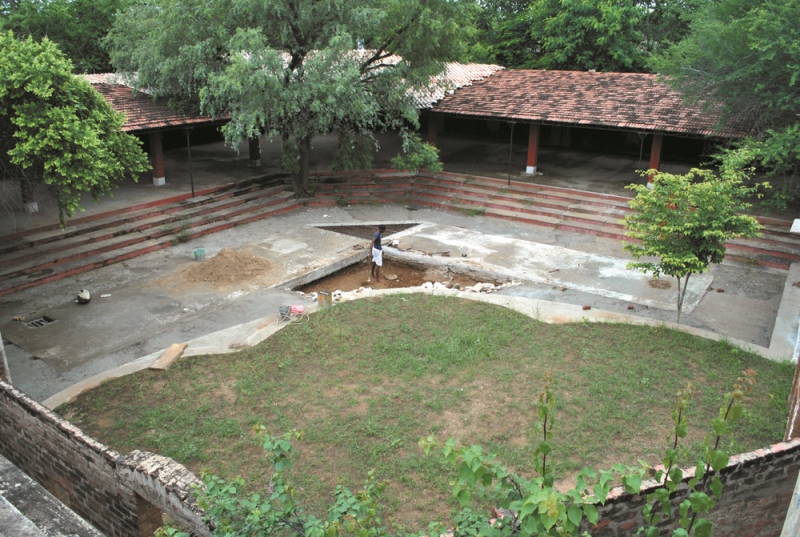While the need for rainwater harvesting is now very widely recognized, the results achieved at many places are not very good. Hence there is much to learn from the experience of those organizations which have achieved high levels of success and repute in such efforts. Quite often when we explore their work we realize that these organizations in turn believe in learning from the traditional wisdom of communities with whom they work and in securing very close involvement of people in their work.
In Rajasthan where rain is scarce and drought is all too frequent, villagers have a rich tradition of rainwater harvesting. The Barefoot College (BC) has revived, improved and improvised this traditional technology to meet the specific need of many diverse areas. If we add up all this work of BC then its rooftop rainwater harvesting structures in 17 states have a total capacity of around 55 million liters.
A visit to some of the villages where BC has taken up this work revealed the extent of community involvement and the efforts made to ensure honesty and transparency. In community meetings members are selected to form a committee for the work being taken up and they together take up much of the local work while the experienced staff continues to provide technical guidance. In some villages I met elderly persons, not very educated in formal terms at all but a conversation with them was revealing in terms of their water related wisdom.
It was also evident from their close rapport with BC activists like Ram Karan that their wisdom in this respect had been well utilized in village water works, mainly relating to water harvesting, taken up by BC.
BC rainwater harvesting work and other water conservation work starts right at its own main campus in Tilonia village of Ajmer district. Carefully designed pipes carry the rooftop rainwater to an underground storage or tanka. Surface water from the nearby hills is guided by trenches and drains to stop for some time and flow into an open well, the overflow being guided into another well. Rooftop rainwater is stored to provide drinking water, while other rain water is used to recharge the groundwater.

In addition the attempts to increase green cover in difficult conditions and the beautiful collection of trees, here as in some other villages of its work area, also contribute to water conservation. The result is that often while hand-pumps in nearby areas go dry in the summer, hand-pumps in this campus continue to provide water throughout the year. The conservation of moisture, careful drip irrigation using a thin pipe, creation of soak pits to conserve waste water all help to contribute conditions where despite the low rainfall and frequent drought-like conditions the BC campus wears a green look, with an abundance of green trees and chirping birds. Sewage water is also recycled for irrigating some trees. The water-storage tankas, with a capacity of about 40000 liters, also provide the stage for an open theatre cum meeting place where over one thousand persons can gather.
Both the new and the old campus of Tilonia provide very good examples of trying to save as much rainwater as possible, an effort which can be seen in most of its other centres and sub-centres as well as the villages of its work-area, particularly the schools of this area.
Rainwater falling on rooftops of schools and some other buildings is channelized into underground leak-proof tanks made of local, low-cost materials. From here water is then taken to underground storages or tankas. Most of the rainwater is harvested for drinking and sanitation. Some of this water is also used to recharge groundwater supplies (mostly utilising unused open wells).
Briefly this involves diversion of surface run off water into unused and abandoned open wells in villages so that more water percolates into the ground and revitalises dry hand pumps and irrigation wells – assets that may be just lying waste. Studies have shown that several hundred thousand liters have percolated into the ground within days.
Ram Karan, co-ordinator of the water-conservation programme of BC informed that water-conservation works such as naadis, anicuts, bunds etc. taken up in and around villages suffering from brackishness help to reduce this brackishness to some extent. As we drove through a vast stretch of sandy wastes, we were impressed by the anicuts, ponds and other structures that have been created to obtain some recharge and reduce brackishness. Sweet rain water that accumulates in ponds can be used by villagers for at least some weeks after the rains.
An important part of the water harvesting work of BC relates to underground water storages or tankas for schools. This not only quenches the thirst of children who earlier used to remain thirsty or roamed around the neighborhood in search of water, in addition this can also contribute to increasing the attendance in school, particularly in poor water quality areas. This helps to reduce the incidence of water-borne diseases. Availability of water storage enables the school to provide sanitation as well..
The secondary school at Tikawara village has a tanka or underground storage with a capacity of about 40000 litres of water. There are steps in the storage so that it is easier to clean it. There is an outlet so that the muddy water which comes initially can be sent out. Then the outlet is blocked so that the filtered inlet can start receiving the water. The 40000 litres of water stored here can meet the needs of this school for 4 to 5 months after the rains. Then around Feb. March they will have to obtain some water-tankers so that the tankas can be filled up till the next rains.
As I went around this area I could see that there were several examples of local improvisation so that such work could be taken up even in very difficult and isolated conditions. I could see this, for example, in the school created for children of salt workers in a very remote place. This was as much a great example of providing education in very difficult conditions as of arranging water for the children here.
Such solutions work out only because of the very close relationship between the voluntary organization and the people , because there is no other motivation except to very sincerely help the community and there is intense involvement on both sides to find solutions in difficult conditions.
Back in his small Tilonia office I sat down with Ram Karan to look at the big files containing detailed records of all expenditures and accounts relating to the various water conservation works so that complete accountability and transparency were also ensured.
Barefoot water engineers from countries like Ethiopia, Sierra Leone and Senegal were also trained here and achieved good results after returning to their villages.
BC and its famous director Bunker Roy have a well-deserved national and world-level reputation for their work in rainwater harvesting and water conservation. Although they have been more busy recently in terms of pandemic related relief and help, water conservation has always been and will remain a big priority for them.
Bharat Dogra is a journalist and author. He has written books on the work of Barefoot College in English and Hindi.











